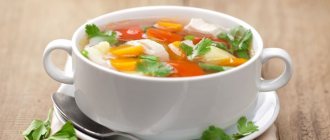Soup can be called the head of our dinner table; since childhood, we have become accustomed to the fact that during the daytime meals should begin with it - a rich, aromatic liquid dish. Today, too, many of us cannot imagine a day without hot soup, because from a very early age we were taught that the “first thing” must be eaten, otherwise we will have neither strength nor health. However, soup has opponents who believe that it is a harmful dish that can ruin our stomach. So is it good to eat soup every day, or can such a habit harm our health? Let's figure it out together.
Soup is rightfully the “first” dish
Soups are a whole group of liquid dishes, the main feature of which is that more than half of it consists of liquid. There are probably millions of recipes for different soups. Many countries have their own soup, which has become a symbol of national cuisine. We have cabbage soup and borscht, the French have onion soup, the Japanese have miso soup that is especially popular today, the list goes on for a long time.
Each type of liquid hot dish has many variations; there are several hundred recipes for borscht alone. Moreover, for example, Russian, Ukrainian or Belarusian borscht can be very different from each other, fueling disputes in interethnic families. After all, each spouse has his own, national, understanding of what this first course should be. For example, in the Russian version of borscht there should be no lard, while in the Belarusian and Ukrainian versions this component occupies an important place in the recipe. And a Belarusian can ask a Russian why you put cabbage in borscht.
Another interesting fact is that soup does not have to be a hot dish; there are many recipes for preparing a cold dish. Each of these soups has its own health benefits and harms; a cold dish will retain more vitamins, but the hot version is considered to be healthier for the stomach. However, this depends on the specific recipe.
Useful tips
If you are not sure about the quality of the meat, then it is better to boil the meat in cold water, bring to a boil, cook for 5 minutes and drain the broth. Then fill the meat with water again and continue cooking as recommended in the recipe.
You can do it this way. Boil the broth, cool it, remove the congealed fat from it. Along with the fat, all harmful substances that were probably “stuffed” into the meat will be removed.
Cook vegetable or cereal broth separately, and boil meat separately. Cut the meat into small pieces and add portions to each plate.
And if you decide to lose weight with soup, as mentioned above, watch this video.
There are just as many different soup recipes as there are many opinions on whether soups are healthy or harmful. You have found out both sides, the choice is yours! And I say goodbye to you until we meet again! Don't forget to subscribe to blog updates! Taisiya Filippova was with you.
The benefits of the first dish
Soup is a great opportunity to enrich our diet with vegetables. Once we roughly count the number of different vegetables indicated in the recipe, we are convinced that this is truly a magical elixir.
It is believed that in order to fulfill the daily requirement for eating vegetables, you can “wrap up” just a couple of bowls of aromatic soup. Therefore, light vegetable soups are considered especially useful.
We can quickly satisfy our hunger with soup, because in order to eat a liquid dish, we don’t need to chew it well. Moreover, the nutritious liquid of soup, especially hot, fills the stomach, dulling the feeling of hunger. If you want to eat something tasty, but not very healthy, eat a bowl of soup first. This way, there will be less “room” in the stomach for that same “tasty, but not the healthiest” dish.
This also explains the benefits of soup for weight loss - we eat up in smaller portions, given the low calorie content of a liquid dish with high nutritional value. Of course, if we are not talking about the notorious lard borscht with donuts. There are even many diets based on various light, mostly vegetable, soups. Such dishes not only satiate us, but also rid the body of waste and toxins. Also, along with soups, our body receives fiber, which is necessary for weight loss and overall health.
The benefit of soup lies in its easy digestibility by the body. The soup contains many useful substances, is easily digestible and does not require much effort to eat it. Therefore, it is actively used during colds; it helps the body, exhausted by viruses, to recover and receive the necessary vitamins. However, the soup should be low-fat and light, so that the body does not have to spend a lot of effort and energy on digesting it, which is needed to resist infections. The dish warms the body well, which is especially valuable in the cold months.
Many soups have a good effect on metabolism and help you lose weight. Pea soups are especially useful in this sense, despite their relatively high calorie content.
Are there any benefits to soups for children?
The benefits of soups for children are sometimes questioned. This is partly surprising, because from childhood we are taught that the first must be included in the diet. However, some modern scientists question the usefulness of the dish, arguing that along with beneficial substances, dangerous components can also penetrate into the child’s body. To ensure that as little harmful substances as possible get into the dish, you should drain the first water of the meat broth. After the meat has cooked for a few minutes, the water needs to be drained and new water added. And only then cook the soup itself.
But kids still need to eat soup, the majority agrees on this opinion. You just need to carefully monitor the quality of the added products and prepare mainly vegetable first courses. If you use meat, then chicken or veal. You should not add bouillon cubes, a lot of seasonings, or garlic to soups for children.
Soup has the same effect on a child’s body as on an adult: it improves digestion, is easily digestible, and helps to gain strength. And puree soups are recommended to be given to small children as the first complementary food. By the way, the first course is with pureed vegetables, and an older child will eat it with more pleasure than ordinary soup, in which, sometimes, unappetizing pieces of vegetables float.
What is puree soup
Despite the fame of an exquisite, and even sophisticated first course, puree soup is not difficult to prepare. Even an ordinary housewife can create such a dish. And some are even able to prepare puree soup by accident, while preparing a regular soup, without monitoring the readiness of the ingredients, thereby allowing them to boil too much. From which the contents of the saucepan can be proudly called puree soup and served as a delicious treat. And there really is some truth in this joke, because the dish is prepared from the same ingredients as ordinary soup, and extraordinary culinary skills are not required to create it.
The puree soup has the consistency of thick cream and is prepared with a white sauce. White sauce is also not something unimaginable or difficult to prepare. This is the name for a decoction of white meat or fish, vegetables or mushrooms, as well as pearl barley or rice. By the way, puree soup made with milk is called “cream soup”. Mostly poultry meat is used to prepare the broth, but sometimes cream soup made from beef or fish is found. The dish is widely known in vegetarian cuisine; in this case, the white sauce for it is prepared from mushrooms.
Products that are added to the main mass must also be prepared in a special way. They are ground using a sieve or pureed with a blender. Before this, the vegetables need to be brought to a boil or simmered, and when they have softened, grind evenly. So that there are not even small pieces. By the way, the best way is considered to be grinding using a sieve. To grind meat, use first a meat grinder and then a sieve.
Harmful properties of soups
Yes, there are claims that soups can be harmful to our health, or that they are not as beneficial as we think. Some claim that 70% of vitamins and minerals are destroyed during cooking and do not go into the broth. But harmful substances get there.
The statement is partially true, but not absolutely all vitamins are destroyed during the cooking process. Vitamin C is destroyed almost completely under the influence of high temperatures. But many B vitamins, vitamins A, E, D, PP are resistant to high temperatures. They are destroyed, but partially, and approximately 70% of the original amount remains in the soup. Fiber is also destroyed slightly during cooking.
Another statement about the dangers of soup is more true: various antibiotics and hormonal drugs that were “fed” to the animal end up in almost their entire composition in the broth. But this can also be avoided: the first water must be brought to a boil and drained, adding new water.
The first hot dishes are harmful to our body due to their high fat content, of course, if we are talking about meat soup. In order not to harm your health and figure, cook non-rich dishes.
Calorie content of vegetable soup with water without potatoes. Vegetable soup
Vegetable soups are liquid dishes prepared with decoctions or vegetable broth without the addition of meat and fish products. 200 types of vegetable soups are officially registered, but in reality there are many more. Each housewife chooses independently whether to cook a soup from a variety of vegetables or one or two ingredients, chop the vegetables coarsely or finely chop them, prepare a light thin soup or thick stew, blend the puree soup with a blender or mash the vegetables with a fork.
Vegetable soups vary in color, clarity, consistency and serving temperature. Additives to vegetable soups traditionally include cereals, pasta, dumplings, croutons, croutons, nuts, seeds and fresh herbs.
Calorie content of vegetable soup
The calorie content of vegetable soup depends very much on its composition; it is approximately 43 kcal per 100 grams of product.
Composition and beneficial properties of vegetable soup
The main purpose of any soup is to stimulate appetite, but now, at the highest speeds of life, lunch can only consist of soup, which should satisfy hunger and be nutritious. Vegetable soup contains dietary fiber, which stimulates intestinal motility and gently cleanses the stomach walls of unnecessary waste and toxins. It is important to preserve vitamins and microelements contained in various vegetables as much as possible, so you should remember that vitamin C almost completely disappears during heat treatment, and lycopene, on the contrary, enhances its beneficial properties.
Harm of vegetable soup
In case of digestive disorders and a “weak” stomach, vegetable soups should be consumed with caution so that increased intestinal motility does not have a negative impact. Some soups can cause excessive gas and discomfort.
How to cook vegetable soup
When choosing a soup recipe, you need to remember that borscht, cabbage soup made from fresh or sauerkraut, and rassolnik can be vegetable if you do not add meat ingredients to them (calorizator). The vegetable soup includes carrots, potatoes, turnips, pumpkin and zucchini, celery root and stalks, broccoli and cauliflower, onions and tomatoes, green peas and green beans, bell peppers, asparagus, sorrel, spinach and other vegetables. Vegetable soups are cooked briefly to preserve the shape and consistency of the vegetables. The soup can be made from both fresh and frozen vegetables.
For more information about the benefits of vegetable soup, see Copying this article in whole or in part is prohibited.
How to make healthy soups
To include soup in your diet without fear of harming your health, you need to follow a number of rules when preparing:
- Prepare meat soups from young animals
- Choose fresh, undamaged food
- Use lean meat and fish
- Vegetables need to be washed well before cooking, but do not soak in water.
- Don’t forget to drain the first broth, which we already talked about
- It is better to first cook the broth with vegetables, and then add meat there, and not do the opposite
- When cooking, it is important to consider what foods can be eaten by people with certain diseases
Diet with broccoli
It is difficult to find a more gentle food than vegetable first courses. As a rule, this is a low-calorie food that is rich in valuable vitamins, easily digestible, and contains a lot of fiber. Broccoli is an ideal product for a diet menu. It contains amino acids, carbohydrates, and proteins. When preparing broccoli soup, you can use different ingredients: asparagus, potatoes, beans, green peas, carrots. Below is a recipe for dietary vegetable broth soup with a photo.
- Chicken gizzards in a slow cooker - recipes with photos. How to cook chicken gizzards in a slow cooker with sauce
- Urticaria in children - causes and symptoms. Types, treatment and diet at home
- Kefir baking recipes
Ingredients:
- broccoli – 360 g;
- celery – 170 g;
- leek – 35 g;
- garlic;
- potatoes – 350 g;
- carrots – 180 g;
- onions – 1 pc.;
- vegetable broth - 1.6 l.
Cooking method:
- Peel and place the onions, carrots and celery in the pan.
- Boil the food in water; when it boils, reduce the heat.
- Cook the broth for 25 minutes.
- Divide the broccoli into florets and chop the stem.
- Peel the potatoes and cut them.
- Cut the vegetables from the broth into pieces.
- Place everything in a saucepan, pour in the strained vegetable broth.
- Cook everything together for about 8 minutes.
Should you eat soup every day?
No matter how many battles there are over the harms and benefits of soup, it is recommended to eat it regularly. Naturally, it will bring benefits if you prepare the first dish correctly, following the above recommendations. But it is impossible to replace solid food with soup, especially for a long time. This can lead to a number of diseases and problems, including lazy bowel syndrome and or dental problems. If the diet is replete with soft foods that hardly require chewing, the gums weaken, not receiving the necessary daily chewing “charge.” In the long term, this can even lead to tooth loss. However, this applies not only to soups.
So is it harmful to not eat soup at all? It is believed that soup, at least not daily, should be present in our diet. For example, soups are very useful for gastritis. While “gastratics” generally have a relatively meager diet, properly cooked soup is a real helper.










